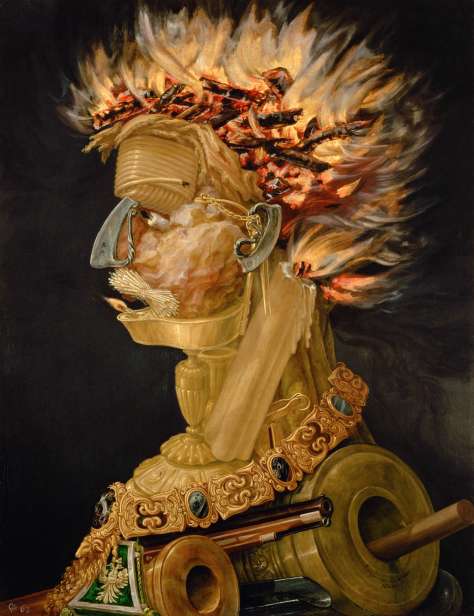
Electro Stimulation is being used for any injuries in a portable unit for physical therapy

Electro Stimulation is being used for any injuries in a portable unit for physical therapy

Giuseppe Arcimboldo’s 16th century Mannerist oil painting, “Fire” (1566), is a collection of found objects of contemporary technology used to create the profile of a cyborg-like figure. The painting represents many fire producing elements including two cannons forming the shoulder and chest of the figure, a musket, a metal oil lamp as the mouth, and several flintlocks as the nose and ears. Arcimboldo’s painting is the oldest known representation of a cyborg figure and indicates the fascination cyborgs, or human-machine systems, have held for humanity through the centuries. Even though Giuseppe Arcimboldo has many different unique paintings created from found objects, his “Fire” is noted for its portrayal of technology and modern relevance. Cyborgs, as stated above, are “living beings whose powers are enhanced by computer implants or mechanical body parts” (Dictionary.com). We can see in this painting that the portrait is not just an ordinary human but an individual composed of mechanical parts that indicate an association between power/wealth and technology (the subject wears the medallion of a statesman). The technology of Arcimboldo’s day, unlike our own, emphasized the destructive power of fire. However, the painting shows the continued association of technology, power, and the future of civilization.
Now that advanced technologies are available readily, the artificial brain and intelligence has been adapted to the battlefield as a military technology evolution.
DARPA (Defense Advanced Research Projects Agency), a segment of the Department of Defense (DOD), has been conducting research intended to, “advanc[e] technology for military uniforms, body armor and equipment have saved countless lives of our service members injured on the battlefield” (2).

With many cutting-edge technologies under development, DARPA is pushing forward the capabilities of military technology and cyborg interface with its Advanced X-Ray Integrated Project, Maskless Nanowriter, and Ultrabeam. Its many different advanced development projects have, “For a decade now… been leading efforts aimed at ‘revolutionizing’ the state-of-the-art in prosthetic limbs, recently debuting two advanced mechatronic limbs for the upper extremity.(2)” Amazingly, DARPA created a portal for direct access to the nervous-control system via prosthetic limbs of subjects. Previously, prosthetic limbs were just connected to residual limbs without the ability for nervous system integration that is a traditional method for humans. 
However, DARPA’s program allows amputee patients to control their nerve system to manipulate their body-integrated machines including high-performance prosthetic limbs. It can be a genuinely active engagement as its provides tremendous progress with technology from a passive engagement and the ability to move, “Furthermore, advances in cortical microelectrode technologies are extending the durability of neural signals obtained from the brain, making it possible to create brain-controlled prosthetics that remain useful over the full lifetime of the patient” (2).
Do Androids Dream of Electric Sheep? is a science-fiction novel written by Philip K. Dick in 1968. Dick’s dystopian novel has had a subtle but strong influence on science fiction as a genre. Electric Sheep, has inspired some of the most well known science-fiction films released in the United States. In his dystopian future corporations have been established that specialize in the mass production of artificial life (androids). Although humanity has made impressive strides in the field technologically, they have regressed socially, and environmentally. The books main character is Phil Deckard, a bounty hunter trained specifically for the task of hunting down Artificial life. The conflict emerges when a group of androids defect from their orders and try to assimilate into society. Phil Deckard is of course given the task of terminating them. Deckard reluctantly goes on to track down the rogue androids through neo Los Angeles. In a series of chess like interrogations, philosophical debates, elaborate lies, shoot outs, chases, beatings and concussions, Deckard ensures that each replicant is terminated. Androids are difficult to tell apart from humans so a lengthy empathy test that appears more like an interrogation, must be administered to ensure they are not human before they are terminated. The dialogue of Electric Sheep takes a philosophical and psychological turn when these test are administered. The process may leave the reader questioning whether it is possible to create a definition of “human.”